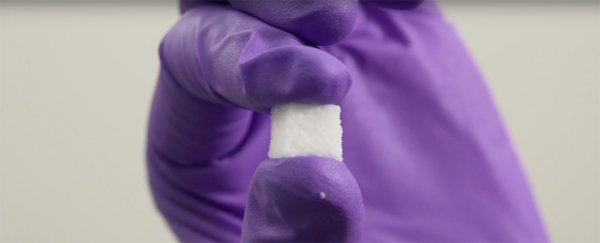A new half-solid, half-liquid adaptive material created by scientists in the US displays a number of amazing properties, including the ability to self-heal – stitching itself back together once divided – and self-stiffen back into its original shape after being compressed.
The material, called SAC – which stands for self-adaptive composite – is composed of a mass of sticky, micron-scale rubber balls that cling together to create a solid matrix. The composite is capable of healing itself repeatedly when cracked, and behaves kind of like a sponge, regaining its original form after being disturbed.
Unlike similar self-healing materials that behave more like liquids, SAC is remarkably solid. "We wanted a biomimetic material that could change itself, or its inner structure, to adapt to external stimulation and thought introducing more liquid would be a way," said one of the researchers, Alin Cristian Chipara from Rice University. "But we wanted the liquid to be stable instead of flowing everywhere."
The solution was to mix two polymers together with a solvent. When heated the solvent evaporates, leaving a porous mass of gooey spheres. The liquid-encasing spheres are made from polyvinylidene fluoride (PVDF) and are coated in a viscous layer of polydimethylsiloxane (PDMS).
"The sample doesn't give you the impression that it contains any liquid," said material scientist, Jun Lou. "That's very different from a gel. This is not really squishy; it's more like a sugar cube that you can compress quite a lot. The nice thing is that it recovers."
The researchers say the composite is easy to manufacture, and the liquid:solid ratio of the final mix can be tweaked depending on how you ultimately want SAC to behave.
"Gels have lots of liquid encapsulated in solids, but they're too much on the very soft side," said one of the team, Pulickel Ajayan. "We wanted something that was mechanically robust as well. What we ended up with is probably an extreme gel in which the liquid phase is only 50 percent or so."
In testing, SAC demonstrated up to a 683 percent increase in its storage modulus – a parameter used to characterise self-stiffening behaviour. According to the team, this is much larger than that reported for solid composites and other materials.
The findings are reported in Applied Materials & Interfaces.
While the material is currently only being made in the 150-millilitre containers the researchers use in the lab, they say they have a design that could scale up process, and believe SAC could be used in a wide range of applications, including as a biocompatible material for tissue-engineering, or as a lightweight, defect-tolerant structural component.
Check out the video below to see this crazy material in action and find out more about how it was developed.

